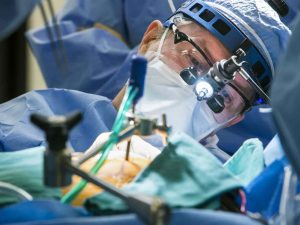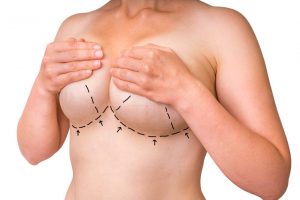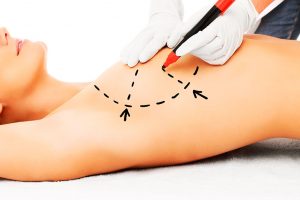mastopexy
Droopiness of the breast is a common legacy of motherhood, nursing and the force of gravity taking their toll, and the effect of pregnancy and a distension of the breasts with milk causes the fibrous bands which support the breasts in their youthful shape to break down and the skin to stretch. With the subsequent shrinking the unsupported breasts settle into the stretched skin and gravity pulls them down. Putting on weight and then losing it can have the same effect. So too does the aging process, which is why women dislike the appearance of their droopy breasts.
What is mastopexy surgery?
Mastopexy surgery, commonly known as a breast uplift, is an operation to remove extra loose skin from the breasts, and to lift and reshape them, to make them look more youthful.
Preparing for Mastopexy surgery
Your surgeon will explain how to prepare for your breast lift surgery. For example, if you smoke they’ll advise you to stop, perhaps for at least six weeks before your surgery. Smoking increases your risk of getting a chest or wound infection, which can slow your recovery. Your surgeon may also recommend that you lose some excess weight if you need to.
You may be able to go home on the day of your surgery, or you may need to stay overnight. If your surgeon says you can go home the same day, make sure someone will be at home with you that night. Breast uplift surgery is usually done under general anesthesia. This means you’ll be asleep during the operation. You’ll probably be asked not to eat or drink anything for about six hours before your operation. However, it’s important to follow your anesthetist’s advice. Your surgeon will discuss with you what will happen before, during and after your procedure, and any pain you might have. This is your opportunity to ask questions so that you understand what will be happening. You don’t have to go ahead with the procedure if you decide you don’t want it. Once you understand the procedure and if you agree to have it, you’ll be asked to sign a consent form. Your surgeon will measure your breasts and assess their shape and the position of your nipples. They may also take photographs for your medical records. Before your surgery, they’ll mark the position of the intended surgical cuts on your breasts. Your surgeon may recommend that you have an ultrasound scan or mammogram (X-ray of your breasts) before your operation.
What to expect afterward
After your breast uplift surgery, you’ll need to rest until the effects of the anesthetic have passed. You’ll be offered pain relief to help with any discomfort you have. You may need to have fine tubes running out from the wound to drain excess fluid into a bag or bottle. These are removed when the fluid or blood has stopped draining, usually before you go home. Before you go home, your nurse will give you advice about caring for your wounds and what to do if you have problems. You’ll also get advice on how to care for your breasts, hygiene, and showering. You’ll be given a date for a follow-up appointment. You’ll need to arrange for someone to drive you home. Try to have a friend or relative stay with you for the first 24 hours after your operation. The medicines used for general anesthesia can stay in your body for a while. Because of this, it’s safest not to drive, drink alcohol, operate machinery or make important decisions for 24 hours after your anesthetic. If you’re in any doubt about driving, contact your motor insurer so that you’re aware of their recommendations. Always follow your surgeon’s advice.
What are the alternatives to breast uplift surgery?
According to what you’re hoping to achieve with breast uplift surgery, there may be an alternative, more suitable cosmetic operation. For example, a breast reduction operation or breast enlargement operation may be a better option for you. Ask your surgeon to explain your options to you.
How is the surgery performed?
There are different types of uplift. The best type of uplift for you depends on your breast size and the result you want. Different types of uplift make different scars on the breasts. Whichever type of uplift you choose, the scars should not be visible when you wear normal clothing, bras and bikini tops. The most common type of uplift, with a cut around your areola and vertically under your breast, is shown below. Sometimes there is a cut in the crease under the breast to make an anchor shape. Extra skin is removed from underneath the breast, the breast is reshaped into a tighter cone and the nipples are moved to a higher level. The size of the areola can also be reduced.
If your breasts are small as well as droopy, you can have them enlarged with silicone implants. Having breast implants is the only way to significantly increase fullness above the nipples, but their weight can make the breast droop again over time.
What are the risks and complications of a breast uplift?
As with all operations, there are risks involved in having a breast uplift. Although the risks are unlikely, it is important to weigh them up against the potential benefit of the surgery.
- Scars There will be scars from the surgery. These will usually be red at first, then purple, and then fade to become paler over 12 to 18 months. Occasionally, scars may become wider, thicker, red or painful, and you may need to have surgery to correct them.
- Bleeding Heavy bleeding is unusual but possible, and you may need a blood transfusion or another operation (or both) to stop the bleeding. Any bleeding usually happens immediately after, or soon after, surgery. Before the surgery your surgeon will discuss any medicines that increase your risk of bleeding, and it is important to control high blood pressure.
- Infection If you get an infection of the wound you may need antibiotics or another operation. This can affect the final result of the surgery. If you have discharge from your nipple, it is important to tell your surgeon about it before the operation, as this can increase the risk of infection.
- Swelling, bruising and pain There will be some swelling and bruising of the breasts after the operation, and this can take weeks to settle. There may be long-term pain, but this is uncommon.
- Healing problems The edges of the wound can come apart, particularly at the ends of the scar. Usually this problem can be put right by dressing the wounds, but you may need more surgery to remove the tissue that hasn’t healed. Smokers are more likely to have healing problems.
- Loss of blood supply to skin, fat, breast tissue or the nipple Some areas of skin, fat, breast tissue or the nipple may die (called necrosis) if the blood supply has been lost during surgery. This may mean that you need another operation, which can affect the final result of the surgery. There may be lumpiness or an uneven surface in an area affected by necrosis. Occasionally, fat may harden, which may interfere with mammograms in the future.
- Increased or reduced sensation After the surgery, most patients will get some alteration in the sensation in their breasts, most commonly numbness near the scar and either increased or reduced sensation in the nipples. In rare cases, the change in sensation may be permanent. Rarely, reduced sensation can cause problems with breastfeeding.
- Damage to deeper structures Although rare, the surgery can damage deeper structures, including nerves, blood vessels, muscles and the lungs. This damage may be temporary or permanent.
- Change over time The appearance of your breasts will change as a result of ageing, pregnancy or other circumstances not related to your surgery, such as putting on or losing weight. You may need further surgery or other treatments to maintain the results of the breast uplift.
- Allergic reaction Rarely, allergic reactions to tape, stitches or solutions have been reported. If you have an allergic reaction you may need extra treatment.







Leave a Reply
Want to join the discussion?Feel free to contribute!